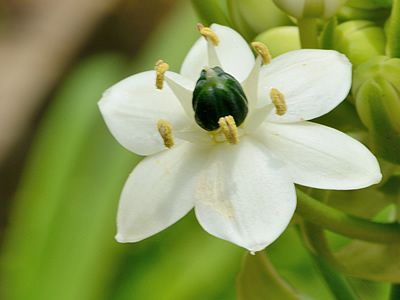The Giant Chincherinchee (Ornithogalum saundersiae) is a bulbous, herbaceous, and flowering plant originally found in rocky clearings in the countries of South Africa, Eswatini, Natal Province, and Mpumalanga, in the subtropics of the African Continent. It stands out for its ornamental qualities, both in gardens and floral arrangements, where it serves as a cut flower. From the underground bulb, erect rosette foliage emerges, with broad, linear leaves about 60 centimeters (24 inches) tall, soft, and dark green and shiny in color.
It blooms in the summer, producing long floral stems, more than twice the height of the foliage (up to 1.5 meters or approximately 5 feet), featuring an umbel-type inflorescence, with a shape between globular and flat. The flowers are numerous, white, delicate, star-shaped, and have a black or green ovary, which stands out by contrast. They open from the edges towards the center of the inflorescence, gradually, and are attractive to bees and butterflies.

A bulbous plant for a stunning effect in garden beds. Being still uncommon, the giant chincherinchee brings a certain exoticism, while conferring an elegant and rustic air, typical of small-flowered bulbous plants. Plant in well-fertilized beds not prone to waterlogging, in groups of 20 or more for a more interesting effect.
The bulbs of the giant chincherinchee can also be planted in pots and planters and mixed with other species. In autumn, it enters a dormancy period, and the leaves wither and fall, to then restart the vegetative cycle in spring. The bulbs can be left in the soil, or removed, cleaned, and stored for replanting. The inflorescences have great durability and can compose beautiful floral arrangements and bouquets.
It should be cultivated in partial shade, preferably receiving morning sun, in fertile, well-drained soil, enriched with organic matter, and watered regularly, without excess. Gradually reduce watering in autumn, favoring the plant’s dormancy period. In winter, suspend watering or water minimally, avoiding bulb dehydration.
Fertilize at planting with slow-release fertilizers and supplement during growth and flowering with liquid fertilizers. Plant the bulbs at a depth of 3 to 5 centimeters (about 1.2 to 2 inches) and spaced about 15 cm (6 inches) apart for better development. Over time, the giant chincherinchee forms dense clumps through the propagation of bulbs, so it is interesting to refurbish the beds and replant, with separation of the plants every 3 or 4 years. It multiplies by division of the bulblets formed around the mother plant and by seeds.


